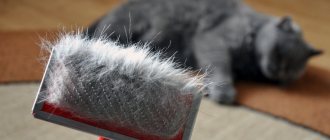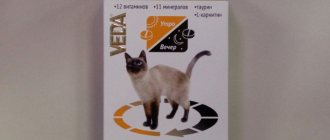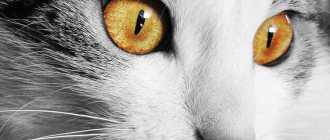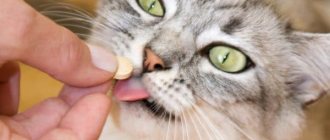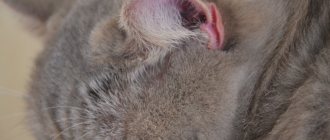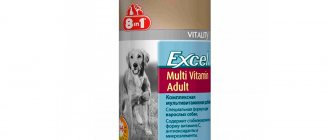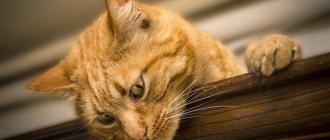Why is anemia dangerous for a cat?
The function of red blood cells in the body is associated with the transport of oxygen to organs and tissues.
Its molecules are transported using a specific protein - hemoglobin, which contains iron atoms. It is this microelement that causes the red color of blood. Without oxygen molecules, not a single biochemical reaction can take place in a living organism. Normally, in a physiologically healthy cat, the hemoglobin concentration in the blood ranges from 80 to 150 g/l. This is the amount of iron-containing protein that can provide the body’s tissues with the necessary oxygen.
Red blood cells are also directly involved in the mechanism of supplying the body with oxygen. A healthy cat should contain at least 5.10*1012/l red blood cells.
Normal blood counts in a cat
When the level of hemoglobin and the number of red blood cells decrease, the animal begins to experience hypoxia (oxygen starvation). Tissues and organs do not receive enough oxygen, and redox reactions and cellular respiration are disrupted. The acid-base balance is disturbed, and the body experiences signs of intoxication.
Oxygen deficiency leads to dysfunction of the cardiovascular system and negatively affects immune structures. The animal quickly loses weight and becomes lethargic. A weakened body is a target for infectious and non-infectious diseases.
Disease prevention
Timely vaccination of your pet will help prevent anemia of an infectious nature. To prevent posthemorrhagic anemia, veterinarians recommend monitoring the animal’s hygiene and deworming it twice a year using special means. Preventing your pet from becoming infected with worms will help protect it from many pathologies, the consequences of which can be very dangerous.
Infectious viral anemia is often transmitted to animals through fleas. To protect your pet from infected bloodsuckers, you should periodically treat it with drugs such as “Advantage” and “Advocate”.
It is important to ensure that a curious kitten does not lick bottles of household chemicals or chew other containers with dangerous contents. You should not leave your animal in a room where toxic substances are stored.
To ensure that your pet receives all the nutrients it needs to stay healthy, it is important to feed it properly. A veterinarian can create a balanced menu. Using high-quality food from a reliable manufacturer will help prevent disorders in the blood composition.
Increased hemoglobin - causes
In veterinary medicine, the causes leading to the development of anemia in domestic animals have been studied quite well. Experts identify the following etiological factors of the disease:
- Injuries, mechanical damage to blood vessels, heavy blood loss. Acute anemia can also be caused by internal bleeding, for example, with a stomach ulcer or ingestion of a foreign object.
- Infectious diseases. The cause of anemia in domestic cats can be viruses, bacteria, protozoa that destroy red blood cells. Viral leukemia, feline immunodeficiency virus - diseases of viral etiology, accompanied by anemia. Anemia also develops when an animal becomes ill with hemobartenellosis, which is more often called feline infectious anemia. Rickettsia (Bartonella) primarily affects red blood cells found in the blood and hematopoietic organs.
- Infestations. Piroplasmosis is one of the common diseases accompanied by the rapid destruction of red blood cells by protozoa. Various helminths (most often nematodes) that live in the cat’s body also lead to a decrease in hemoglobin levels. Severe damage to the animal by blood-sucking parasites is often the cause of anemia in small kittens.
- Hemolytic poisons. Toxic substances such as lead, mercury, nitrobenzene, copper sulfate, and gasoline have a destructive effect on red blood cells.
- Medicines. An overdose of sulfonamide drugs, cardiac glycosides, or the use of paracetamol leads to a hemolytic effect in the body of a furry pet.
- Diseases of internal organs. Chronic diseases of the kidneys, liver, and spleen often lead to anemia. Any prolonged inflammatory processes can lead to the destruction of red blood cells or disruption of hemoglobin synthesis. Diseases of the small and large intestines cause impaired absorption of iron into the blood.
- Neoplasms, including oncological ones. Tumor cells produce toxins that have a hemolytic effect on blood cells.
- Transfusion of incompatible blood group. In newborn kittens, the cause of the disease may be neonatal isoerythrolysis (pathological discrepancy between the maternal and fetal blood groups).
- Failure in the immune system, disruption of the formation of blood cells in the bone marrow.
- Nutritional factor. A deficiency of iron, copper, cobalt, B vitamins and microelements in a cat’s diet leads to a decrease in hemoglobin synthesis. Food from the table and an unbalanced diet lead to a decrease in the level of phosphates in the blood, which leads to anemia.
A decrease in the amount of oxygen supplied leads to a decline in the performance of all body systems. Low hemoglobin in a cat is a consequence of the death of some red blood cells. A decrease in hemoglobin in animals and people is usually called anemia. The disease in cats is accompanied by the following symptoms:
- Blueness or pallor of the mucous membranes is a fairly “broad” symptom that may indicate a number of abnormalities other than anemia. Less commonly, the mucous membranes turn yellow - either liver failure or sudden death of a large number of red blood cells.
- Weakness, drowsiness - trying to restore strength, the brain inhibits all vital systems, which leads to lethargy, and in severe cases, lethargy.
- Increased heart rate and breathing rate are a consequence of oxygen starvation of cells.
- A metallic smell from the mouth is often caused by the destruction of red blood cells due to a lack of iron in the body.
- Chills, limbs that are cold to the touch, and a decrease in base body temperature are a consequence of a slowdown in metabolic processes and overload of the heart muscle.
- The desire to eat something inedible (pica) - the animal licks or tries to chew whitewash, plaster, wallpaper, metal, tray filler, soil, fabrics, and sometimes excrement.
Calculating a treatment strategy involves identifying the root causes of the disease. Globally, the causes of anemia are divided into:
- Blood loss - ulcers, closed and open injuries.
- Hemolytic - leukemia, congenital hematopoietic disorders, autoimmune diseases, toxicosis or poisoning, lack of phosphates, blood transfusion from an inappropriate donor, iron deficiency.
- Non-regenerative (irreversible) - viral leukemia, feline immunodeficiency, bone marrow dysfunction, leukemia (oncology), chronic congenital diseases, incurable renal failure.
Contact your veterinarian for advice on how to increase blood hemoglobin in cats. If no serious pathologies are identified, they begin with a change in diet, introducing: red meat, liver, hematogen without sugar or other blood-containing products, iron supplements, specialized food to increase hemoglobin. In acute conditions the following is prescribed:
- Blood transfusion or infusion of a synthetic substitute.
- Supportive and replacement therapy.
- For viruses and bacterial infections - antibiotics.
- For autoimmune diseases - corticosteroids or other drugs that inhibit the functioning of one's own immune system.
Elevated hemoglobin in cats is a more dangerous symptom, and its underlying causes are fleeting. Reduced hemoglobin, a slowdown in metabolic processes and the development of pathologies gives a chance to “gain time” for examination and determination of the root causes; in the diametrically opposite case, the doctor and owner have a minimum of time and only a few attempts before death.
If your cat’s hemoglobin is elevated, and at the same time you observe diarrhea, vomiting, and periodically unnatural body postures (hunched over, crouched gait), urgently take the animal to the clinic for an ultrasound of the abdominal cavity.
Among chronic diseases, an increase in hemoglobin is accompanied by diabetes, congenital abnormalities in the process of blood formation, leading to constant thickening of the blood. Closely monitor blood counts after burns, especially if more than 20% of the body is affected. An increase in hemoglobin indicates complications and internal intoxication.
Summarizing
Anemia in cats is a dangerous disease, which, coupled with the underlying cause, can end the life of a pet. An attentive owner will certainly notice the first signs of anemia - depression, lack of appetite, lightened mucous membranes - and seek help from a veterinary clinic. It is important to remember that making a diagnosis is impossible without conducting various studies, and only after them can a correct treatment regimen be prescribed.
There is good news: congenital anemia is not so common, and acquired anemia can be easily excluded. If the cat moves a lot, receives a balanced diet, is treated for parasites in a timely manner and lives in a comfortable home environment, there will be no reason for the development of anemia. Take care of your pets, and they will not only respond to you with affection and affection, but will also delight you with excellent health for many years.
Signs and Symptoms of Anemia in Cats
An owner can suspect a blood disease in a pet by paying attention to the following symptoms:
- Lethargic state. The animal moves little, sleeps a lot, ignores games, and does not respond to external stimuli.
- The mucous membranes may have a bluish tint or be pale. In the hemolytic form, the mucous membranes acquire an icteric tint.
- The body compensates for the lack of oxygen in the blood by increasing the work of the heart. In this regard, the sick cat exhibits tachycardia and signs of heart failure, for example, difficulty breathing, shortness of breath.
- Loss of appetite, anorexia.
- Decrease in live weight.
- Newborn kittens are delayed in growth and development.
Such general and uncharacteristic symptoms make it difficult to independently diagnose a disease in a pet.
Diagnosis of anemia in cats
If a blood disease is suspected, the animal must be shown to a veterinarian. The following clinical research methods will help make a diagnosis:
- Complete blood count and hematocrit determination. Allows you to detect the level of hemoglobin in the blood and determine the number of red blood cells. A decrease in these indicators below normal allows one to suspect anemia.
- Hematological blood test. The method allows you to determine anisocytosis (change in the size of blood cells), the presence of immature red blood cells.
- Biochemical analysis for iron content in the blood.
- Blood clotting test.
- Bacteriological and virological studies if the infectious nature of the disease is suspected.
For a differential diagnosis, an ultrasound examination of the kidneys, a scatological analysis for intestinal bleeding, and an X-ray examination to exclude tumors may be prescribed.
How to treat anemia in cats
The tactics of therapeutic measures depend on the causes that led to the disease. In acute forms associated with blood loss, emergency blood transfusion is indicated in a specialized institution, taking into account the compatibility of blood groups.
Drugs that increase blood clotting (Vikasol, calcium chloride) are also used.
If the cause of anemia is infectious diseases, complex antimicrobial and antiviral treatment is used. The animal is prescribed immunomodulators and vitamins.
Hemolytic anemia requires the use of antitoxic therapy aimed at eliminating the effects of toxins. For this purpose, intravenous injections of glucose and saline are used.
In the nutritional form of the disease, iron-containing drugs, for example, Ferrovet, Ferranimal and others, have a therapeutic effect. The pet is prescribed vitamin complexes containing B vitamins.
Alimentary lymphosarcoma
Tumor masses in alimentary lymphosarcoma are located in the wall of the digestive tract and can spread to the misenteric lymph nodes. Most often, the tumor is found in the small, cecum or large intestine, less often in the stomach and rectum. Sometimes diffuse infiltration of a large part of the intestine is detected.
Weight loss and anorexia are clinically evident. Vomiting occurs when a tumor blocks the lumen of the small intestine. If the tumor is diffusely distributed in the small intestine or in the lower part of the intestine, then diarrhea and exhaustion occur. Anemia occurs. The disease is more common in cats at an average age of 8 years. Only 30% of cases test positive for viral leukemia.
What to feed the animal
In case of blood diseases, in addition to proper treatment, the nutrition of the sick animal is of no small importance. The diet should contain complete proteins. For this purpose, a sick cat’s diet should include lean beef, turkey, and chicken.
It is useful to give offal twice a week. An obligatory component of the diet should be vegetables rich in iron, copper, cobalt and vitamins. For proper bowel function, lactic acid products are recommended.
Nutrition for anemia
Vaccination
The Purevax FeLV vaccine is used to prevent feline viral leukemia. It is strongly recommended that cats be tested for viral leukemia before vaccination. Primary vaccination is carried out at 8 weeks of age and older, repeated injection – after 3-4 weeks. Revaccination – after 12 months and then annually.
The Leucocel 2 vaccine is also used. Kittens are vaccinated from 9 weeks of age twice with an interval of 3-4 weeks. Revaccination of animals is carried out after 12 months and then annually. All susceptible cats that are in contact with each other should be vaccinated at the same time.
Vaccination has no effect on diagnostic tests for feline leukemia virus infection.
